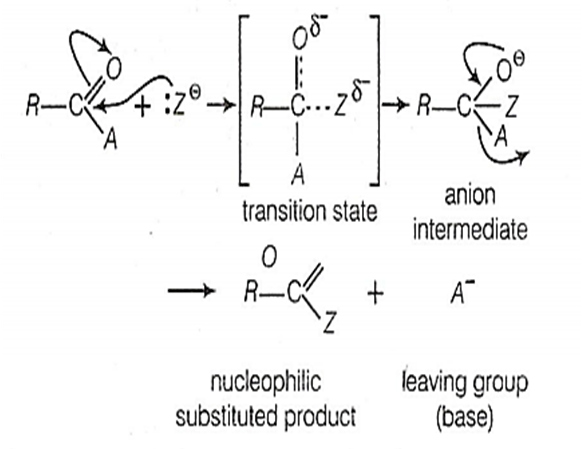 Multiple Choice Questions
Multiple Choice QuestionsIf the for a given reaction has a negative value then which of the following gives the correct relationships for the values of G° and Keq?
< 0; Keq > 1
<0; Keq < 1
> 0; Keq < 1
> 0; Keq > 1
Which of the following is an example for heterogeneous catalysis reaction?
2SO2(g) + O2 2SO3(g)
Hydrolysis of aqueous sucrose solution in the presence of a aqueous mineral acid
2H2O2 (l) 2H2O2(l) + O2(g)
Hydrolysis of liquid in the presence of aqueous mineral acid
The relative reactivities of acyl compounds towards nucleophilic substitution are in the order of
acyl chloride > acid anhydride > ester > amide
ester > acyl chloride > amide > acid anhydride
acid anhydride > amide > ester > acyl chloride
acyl chloride> ester> acid anhydride > amide
A.
acyl chloride > acid anhydride > ester > amide
Nucleophilic substitution reaction is a class of reaction in which an electron rich nucleophile selectively bonds with or attacks the positive or partially positive charge of an atom or a group of atoms to replace a leaving group. The ease of nucleophilic substitution depends upon the nature of leaving group. When the leaving tendency of a group in a compound is high, then the compound is more reactive towards nucleophilic substitution. The nucleophilic acyl substitution is completed in two steps as shown below

The reactivity of the compound may be explained on the basicity of the leaving group. A weaker base is a better leaving group. The basicity order is as
CI- > RCOO- >RO- >N
Hence, the order of the leaving tendency is
Cl- > RCOO- > R-O- > N
and therefore, the order of reactivity of acyl compound is as

Acyl chloride > Acid anhydride > Ester> Amide
Clemmensen reduction of a ketone is carried out in the presence of which of the following?
Zn-Hg with HCl
LiAlH4
H2 and Pt as catalyst
Glycol with KOH
Which one of the following is employed as antihistamine?
Diphenyl hydramine
Norethindrone
Omeprazole
Chloramphenicol
In DNA, the complimentary bases are
adenine and thymine; guanine and cy1osine
adenine and thymine; guanine and uracil
adenine and guanine, thymine and cytosine
uracil and adenine; cytosine and guanine
Which one of the following does not undergo iodoform reaction?
Secondary butyl alcohol
Iso-propyl alcohol
Diethyl ketone
Ethyl alcohol
Which of the following compounds gives carbylamine test?
N-methyl-o-methyl aniline
N, N-dimethyl aniline
2, 4-diethyl aniline
p-methyl-N-methyl benzylamine
